Landing Craft Gun (Large) - LCG (L) 19.
LCGs were aptly described by the BBC as "Mini Destroyers"
 LCG
(L) 19 was a converted landing craft tank (LCT) with the loading bay decked over
and
fitted with two single 119-mm (4.7-in) guns. It provided supporting fire
in the area of landing beaches during amphibious assaults. The BBC, in a
broadcast to the nation, described these craft as "mini destroyers".
LCG
(L) 19 was a converted landing craft tank (LCT) with the loading bay decked over
and
fitted with two single 119-mm (4.7-in) guns. It provided supporting fire
in the area of landing beaches during amphibious assaults. The BBC, in a
broadcast to the nation, described these craft as "mini destroyers".
[Photo; LCG (L) 680 at sea was similar to LCG (L)19.
© IWM (FL 5995)].
LCG (L) 19 became home to linesman,
Harold Dilling for over two years,
during which time he faced both man made and natural hazards.
Background
Harold's daughter,
Christine Cawdron, takes up the story.
In September, 1939,
two 16 year-olds lived in SE London with their respective families near the
Hither Green railway marshalling yards - a prime target for German bombers.
During the Blitz, the roof of one of the houses was blown off, so the two
families shared the same house and that is how my parents came to know each
other!
In the first year of the war dad worked as a marine
engineering apprentice during the day, a reserved occupation(1) and at the local
'Air Raid Precautions' (ARP)
post at night. When unexploded incendiary bombs(2)
fell, he stuffed them into his jacket, cycled
back home and
defused them on the kitchen table! With such a 'devil may care' attitude to
danger, epitomised by damage he caused to the family home on several
occasions, he volunteered for the Navy half way through the 2nd year of his
apprenticeship.
Na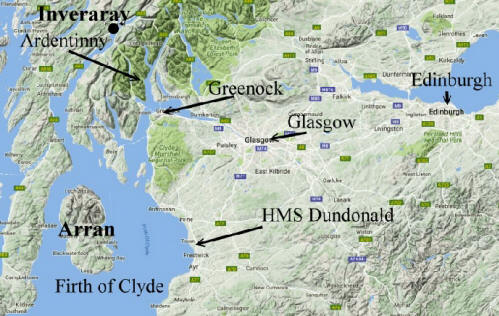 val
Training
val
Training
In early 1942,
he attended HMS Royal Arthur, a requisitioned
Butlin's holiday camp at Skegness, which became a central reception depot
providing basic training for new recruits. Undefined training in mines, torpedoes
and electrical work followed at Portsmouth and Devonport, where he and some
other trainees responded to a recruitment memo by volunteering for the Naval
Commandos. They were soon on their way to Scotland, over 400 miles (640k) to the
north.
[Map courtesy of Google Map Data 2017].
With the Germans occupying most coastal areas of
mainland Europe and North Africa, any raids or landings would come from the sea
onto unimproved landing beaches. They trained in operating flat bottomed landing craft
during mock beach landings in and around the River Clyde estuary at the
No 1 Combined
Training Centre near Inveraray, HMS Dundonald at Troon in Ayrshire, Lamlash on the Isle of
Arran and the Kyle of Lochalsh, a hundred miles to the north.
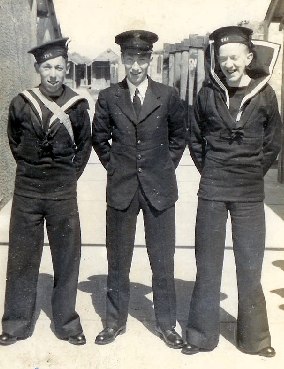 By
late 1942, they were practising Commando style unarmed combat in addition to
landing craft training and during a period at Scapa Flow in the Orkney Islands, off the north coast of
Scotland, he was assigned to LCT 368 (Landing Craft Tank) for 'torpedo nets' training.
Why they needed this training was not immediately evident; but it soon would be!
By
late 1942, they were practising Commando style unarmed combat in addition to
landing craft training and during a period at Scapa Flow in the Orkney Islands, off the north coast of
Scotland, he was assigned to LCT 368 (Landing Craft Tank) for 'torpedo nets' training.
Why they needed this training was not immediately evident; but it soon would be!
[Photo; Harold Dilling is in the centre of this
group].
One evening their LCT was moored in the vicinity of HMS Malaya when a storm
ran through; not unusual in these northerly latitudes. In the morning, they
received urgent orders to lift
the torpedo nets and their associated booms to which
they
were attached. The nets protected the fleet anchored in Scapa Flow from attack
by enemy submarines. It
transpired that during the storm, a King George
V class battleship had been holed in the portside bow area by a boom that had
broken loose. 'There was a lot of gold braid anxiously peering over the
side of the battleship that morning.' said dad.
Training completed, in early 1943 they left Scapa Flow by sea
for Scrabster near Thurso and then by train to Liverpool, where they were
introduced to a bedraggled and forlorn LCT under conversion to an LCG
(L). On completion of the work, the craft became LCG 19 skippered by Lt
Archie Walls from Stirling.

[Right; extract from the admiralty's 'Green List' showing the disposition of LCG
19 in June1944].
As part of a flotilla, they steamed from Birkenhead
to Falmouth via Milford Haven, where they picked up the Marine gunners.
Father had expressed concern to ‘Jimmy the one’
(first
lieutenant) about the seaworthiness of the craft. His knowledge
acquired during his marine engineering apprenticeship suggested that
the open foc’sle area would take in huge quantities of water in heavy weather,
with the distinct possibility of overwhelming the pumps. As bad luck would have
it, they hit a
storm in the Irish Sea and some similar craft were lost. The surviving craft in
the flotilla were recalled to Birkenhead, where LCG
19 was modified with extra steel decking fitted to the bow area.
Operations
On completion of the work, LCG19 joined a flotilla
bound for Gibraltar via Falmouth. However, she suffered engine failure, fell
behind and was soon alone in the vast expanse of the Atlantic. At dawn the
following morning, repairs were carried out by engineers from a cruiser and they continued on their way to
Gibraltar. They then proceeded along the north African coast to Algeria and
Bizerta, where orders were received to proceed to Sicily. In the morning, the
crew were amazed to see a vast armada of vessels of many types around them, all
destined for Sicily.
 LCG 19 was equipped with two
rapid fire pom-pom guns, positioned aft on the port and
starboard sides of the bridge. They were manned by Naval seamen. The heavy
armament comprised two 4.7 inch Bofors
guns manned by Royal Marine gunners and situated on the main gun deck. There were about
32-35 crew members, both Naval and Royal Marine seamen.
LCG 19 was equipped with two
rapid fire pom-pom guns, positioned aft on the port and
starboard sides of the bridge. They were manned by Naval seamen. The heavy
armament comprised two 4.7 inch Bofors
guns manned by Royal Marine gunners and situated on the main gun deck. There were about
32-35 crew members, both Naval and Royal Marine seamen.
[Map courtesy of Google Map Data 2017].
Starting in July, 1943, LCG 19’s war began in
earnest with the invasion of Sicily at Licata followed
by Salerno (early Sept 43), Anzio (Jan 1944),
Elba (Jun 44) and Yugoslavia (May
1945?). According to dad 'We
worked our way up the entire western coast of Italy from the toe to the Bay of
Naples.'
For the Elba operation, an Escort, Scouting and Control Group was included in the Battle Group (LCGs 14, 19 and 20).
In overall command was Comdr Robert A Allan RNVR. Targets for the LCGs were
identified by fast American Patrol Torpedo Boats and their bearing locations
communicated to the LCGs by radio from the Control Group (PTs), who were directing operations. The
Scouting Group (PT’s) sailed ahead searching for and reporting targets while
acting as a
screen against enemy destroyers, if encountered.
In addition to their intended use and functions, the LCGs ferried supplies and small special units from ship to shore, including the
Desert Rats, Ghurkhas and FOO(3) parties and picking them up again as required.
Dad said the LCGs were 'first in and last out'. He had great respect for the
Ghurkhas of whom he said, 'They left the craft
so silently that you wouldn’t realize they had gone and would return in the same
fashion. You would find them turning out their "ditty bags" with trophies
they had gathered from their exploits, including the odd finger or thumb. Thank
heavens they were on our side!'
On the evening of the 27th March, 1944,
six German F-Lighters
(4), escorted by two destroyers, were spotted moving south along the
Italian mainland coast near San Vincenzo to the north of Elba. The mixed force of
American and British craft attacked. The LCGs illuminated the targets with
 star
shells, causing the German gunners to fire skywards believing they were under
attack from the air. To quote,
'That gave the Royal Marine gunners on the
LCGs all the opportunity they needed.
Within 30 seconds one of the F-Lighters blew up with a tremendous explosion.
Within 10 minutes three others had been set afire. The LCGs then reversed course
and caught the last two F-Lighters as they attempted to retire from action.'
[Source "At Close Quarters". See Further Reading below].
star
shells, causing the German gunners to fire skywards believing they were under
attack from the air. To quote,
'That gave the Royal Marine gunners on the
LCGs all the opportunity they needed.
Within 30 seconds one of the F-Lighters blew up with a tremendous explosion.
Within 10 minutes three others had been set afire. The LCGs then reversed course
and caught the last two F-Lighters as they attempted to retire from action.'
[Source "At Close Quarters". See Further Reading below].
[Photo; a surrendered F-Lighter].
Commander Allan praised the accuracy of the LCG
gunfire and the way in which their hurried manoeuvres had been carried out. Of
the six destroyed vessels he reported, 'Two, judging by the impressive
explosions, were carrying petrol, two were carrying munitions and one a mixed
cargo of both. The sixth sank without exploding.' [Source of quote "At Close
Quarters"].
LCGs 14, 19 and 20 took part in another action on the night of April 24-25, 1944,
when two enemy convoys were spotted; one proceeding southwards from Vada Rocks
and the other northwards near Piombino on the Italian mainland to the east of
Elba. Dad remembers slipping between these
two convoys and after the northbound convoy had passed, the southbound one was
attacked.
'Commander Allen moved in on the convoy and gave the order
for the LCGs to open fire at 3,000 yards range. The first star shells
illuminated the two F-Lighters. In less than 3 minutes they were hit by the LCGs and exploded. Star shells landed on high wooded ground near the beach and
started large brush fires, which, together with the burning and exploding
F-Lighters, made
a vast and brilliant glow visible in Bastia 50 miles away. A large ocean going
tug and more F-Lighters were illuminated to the north. The tug was hit
repeatedly by the LCGs and sank, one F-lighter blew up and another burned
furiously and exploded.' [Source "At Close Quarters"].
The Escort Group went inshore to pick up survivors
and took the opportunity to set ablaze an abandoned F-lighter. Meanwhile, the
Battle Group moved to attack a target coming from the north. The LCGs attacked three more F-Lighters and apparently caused two to burn through,
exploding ammunition in the process.
Whilst patrolling around Elba, LCG 19 pulled a mine under
itself. Oblivious to this, dad had just come off his watch and decided to stay on deck
rather than to go below to sleep. He found a suitable flat area in front of the
wheelhouse, where he was shielded from the elements and settled down. In an
instant, he saw
millions of coloured stars and found himself slumped over the wheel in the
wheelhouse with water pouring in from above. The ships engines were screaming
and someone was calling over the intercom, 'Slow ahead'. Dad’s retort was, 'The
engines are b.......d!'
He smashed his way passed the jammed door of the
wheelhouse and the Captain’s cabin door,
to free him from his cabin. He then went below to check on Stoker Porter and on
returning to the deck two seamen, with one lifebelt between them, were engaged
in polite conversation; 'I think that is mine.' (takes lifebelt). 'No, I believe it’s mine.' (other takes lifebelt back).
'No really, I think it’s mine.' (first takes it back again.)
Both must have been dazed by the shock of the explosion, since the craft wasn’t even sinking!
LCG 19 was towed to Taranto for repairs and the crew dispatched to Messina until the craft was
repaired. Dad undertook repair and maintenance work on LCRs (Landing Craft
Rocket) at Reggio, rejoining the
rest of the crew in Messina after a train journey which took several days in
a cattle truck! On rejoining LCG 19, they discovered it had been fitted with a
12lb gun at the bow – the only LCG to have such a powerful weapon.
 Towards
the end of the war the craft operated between Bari and the
Dalmatian Islands, where LCG 19 was involved in attacks on the islands of Pag,
Krk and Cherso. The craft was mentioned in "Yugoslavia and The Dalmatian
Islands" by Vernon Copeland, for the BBC’s WW2 People’s War, in which LCGs 4, 19
and 20 joined up with other vessels to transport Partisans to the islands for
'mop up' purposes.
Towards
the end of the war the craft operated between Bari and the
Dalmatian Islands, where LCG 19 was involved in attacks on the islands of Pag,
Krk and Cherso. The craft was mentioned in "Yugoslavia and The Dalmatian
Islands" by Vernon Copeland, for the BBC’s WW2 People’s War, in which LCGs 4, 19
and 20 joined up with other vessels to transport Partisans to the islands for
'mop up' purposes.
[Photo; Zara, Yugoslavia, May 1945 on the port pom-pom;
front left to right, Ginger Cowie and Alf Gooch; back row left to right, Bardy
Smith, Costello, Gillen, and Burchell].
At the end of the war, whilst waiting to return
home, two naval seamen (one of whom was dad) plus two Marines were given
two days shore leave at Taormina. Whilst there, they received a message, 'Return
to ship – paint pots and brushes at the ready. We’re going home.'
Reflections
Of Salerno dad said, 'It was not good. To begin with, the whole
assault fleet arrived well off shore but was held back a whole day. Apparently
the Allied politicians/ Italian Government were negotiating the surrender of the Italian
forces.
It gave the Germans 24 hours to get fully ready for the attack. Anzio was even
worse. They wasted 3 days just establishing a beachhead with no opposition
whatsoever. Then the Germans hit us well and truly.'
He further recalled a
particular event off Anzio, 'A hospital ship lay
starboard and astern of LCG 19 and was fully lit
as required by convention at the time. With lights on and distinct markings, the
ship should not have been targeted by enemy planes or heavy guns. However, one day
when I was aft, starboard side of the bridge,
an enemy plane came in from the starboard side. Kenneth Paynter,
a signalman (bunting tosser),
who was
forward,
port side, dashed round to where I was standing looking aft. He yelled, 'Germans
coming in starboard side.' We mounted the pom-poms.
The planes flew so low that
we could see their flight deck. Neither of us had any real gunnery experience
and the single barrel pom-pom was a pig of an antique unit. We had to sight the
gun and turn the control handles whilst standing on the gun platform and the whole
thing juddered as we rotated it. We got off several bursts, sufficient
to put the pilot off his flight path towards our hospital ship, although I'm sure we didn't hit the plane. We later heard that the Captain of the
hospital ship had made
a recommendation for the action by LCG 19, which led to the abortion of the
attack on his ship. As far as I can recall, Paynter got a mention in
dispatches.'
The attack on
Elba was led by the French
and was supposed to
be top secret but dad maintained, 'As we came around the headland the Germans
were ready and waiting for us. The operation was as leaky as a sieve.'
During the attacks at Elba, seaman Costello was injured. He
was standing next to my father and said to him, 'I’ve been hit.' Dad told him
not to be so daft as he was still standing but, on closer
inspection, a bullet had passed straight
through the flesh of his inner thigh, leaving a clean hole.
Photo Gallery - click to enlarge. Photos below
provided by Christine Cawdron and Brian Cherry.

Forward gun firing on a Dalmatia Island (Krk
or Pag) in northern Yugoslavia. The island surrendered shortly after the
bombardment.

1945 on the quarter deck. Back Row
L to R - Burchell, Smith, Dilling & Porter. Front Row L to R - Cowie & Gillen.
 A Forward
Observation Party with crew members proudly showing captured German
flags somewhere in the Adriatic. Harold Dilling 2nd from right back row and his colleague, Andrew E Cherry,
marked with an X.
A Forward
Observation Party with crew members proudly showing captured German
flags somewhere in the Adriatic. Harold Dilling 2nd from right back row and his colleague, Andrew E Cherry,
marked with an X.

LCG 19, May
1945
returning from Dalmatia, (Yugoslavia) on the Adriatic Sea with LCG 4
in the background.

Royal Marine
gun crew.

Photo call
somewhere in the Adriatic.
 Royal
Marine Ferguson instinctively ducks at the sound of a 'near miss' enemy shell.
Royal
Marine Ferguson instinctively ducks at the sound of a 'near miss' enemy shell.
 In port.
Boxing was a popular pastime on board LCG 19. Andre E Cherry in the
background as Bert Reynalds and Capstake box with Pincher in the ring
looking on.
In port.
Boxing was a popular pastime on board LCG 19. Andre E Cherry in the
background as Bert Reynalds and Capstake box with Pincher in the ring
looking on.
 Royal Marine Gunners relaxing in Naples, Italy. Far right is Andrew E
Cherry with Albert Major &
Cpl Bert Hayward.
Royal Marine Gunners relaxing in Naples, Italy. Far right is Andrew E
Cherry with Albert Major &
Cpl Bert Hayward.
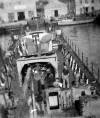 In port with
view of the rear of the aft gun turret.
In port with
view of the rear of the aft gun turret.
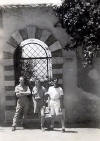 Sightseeing
in the hot sun of the Mediterranean. Harold Dillings on the left.
Sightseeing
in the hot sun of the Mediterranean. Harold Dillings on the left.
_small.jpg)
LCG 19, May 1945
returning from Dalmatia, (Yugoslavia) on the Adriatic Sea with LCG 4
in the background.
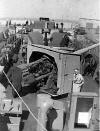 May 1945.
Guns at rest in port with clear view of gun mechanism..
May 1945.
Guns at rest in port with clear view of gun mechanism..
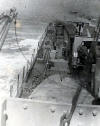
May 1945.
Rough weather in the Adriatic off Dalmatia, Yugoslavia.

1945. Cherso,
Greece? Forward
Observation Party with captured German flag.

 Royal
Marine Gunner, Andrew E Cherry in Taranto, Italy on 8/7/44 in his summer kit
with a record of his service on LCG 19.
Royal
Marine Gunner, Andrew E Cherry in Taranto, Italy on 8/7/44 in his summer kit
with a record of his service on LCG 19.
Postscript
My mother had been called up to work in the War
Office in the Admiralty as a civilian, classified as 'Equivalent Naval Officer.'
She worked 14 hour shifts in the Registry, deep underneath the Admiralty.
The
photo opposite shows some of the "Admiralty girls", who received messages about
the location of all vessels and their current status. One poor girl took a
message that a sub had been hit and sunk and that there were no survivors. It
then became apparent that it was the sub on which her husband was serving.
After the war
mum let on that she always knew where my father's craft was and she knew about a
storm in the Irish Sea, where she always believed that 13 landing craft had been
lost. It was never clear which incident this was but one possibility is the
The 9th LCT Flotilla
of
October 1944.
[Photo opposite; The Admiralty Girls" in Trafalgar
Square (Mum is second from right)].
Because of her work in the Admiralty, my mother knew
that LCG 19 was coming home but, on
this occasion, she broke with the Admiralty convention of secrecy and told the
family, particularly her future father-in-law. He was an HM Customs Officer (Water-guard)
and was able to pass a message to colleagues at Falmouth to assist the crew
ashore with the minimum of fuss from the Customs. Hence, on reaching Falmouth
harbour in early July 1945, they were quickly paid off and dispatched homewards.
Dad had essentially gone to war on a one-way ticket
with the proviso that, if he survived, he would be de-mobbed as soon as war was
ended. He was one of the youngest on board – indeed possibly the youngest. On
July 21st, 1945, Mum and Dad were married. Sadly mum died in 2010 at the age of
86 after 64 years of marriage.
Further Reading
On this website there are around 50
accounts of landing craft
training and operations and
landing craft training establishments.
At
Close Quarters" (PT Boats in the United States Navy) by Captain R J Bulkley
1962, p308-311, published by The Naval Institute Press. The author states that ""Operation Gun",
designed to stem the flow of German shipping down the west coast of Italy, was built around three British LCGs,
landing craft which had been fitted with two 4.7 inch guns and two 40mm guns,
manned by Royal Marine gunners. The Battle Group comprising LCGs 14, 19 and 20, was screened from possible E-boat attack during the operation by an Escort Group,
MTB 634 and MGBs 662, 660 and 659."
There are around 300 books listed on our
'Combined Operations Books' page which can be purchased on-line from the
Advanced Book Exchange (ABE) whose search banner checks the shelves of thousands
of book shops world-wide. Type in or copy and paste the title of your choice or
use the 'keyword' box for book suggestions. There's no obligation to buy, no
registration and no passwords. Click
'Books' for more information.
BBC People's War Archive;
A Happy Craft LCG
19 by Kenneth Paynter.
Acknowledgements
This page was written by Christine Cawdron on behalf of her father Harold Dilling,
now 87 (2010), who served aboard LCG 19 as a linesman, service number 95684 (he thinks).
It was redrafted by Geoff Slee for presentation on this website and approved by
the author before publication. Harold Dilling rarely spoke about his war service
but gave some photos to his daughter which, together with anecdotes and other
information supplied by him, form the basis of this article. Supplementary
information gathered by the family over the years and information gleaned from
other sources were also used.
Explanatory Notes
1. An occupation of importance to the war effort that excused
the worker from military service.
2. Bombs designed to cause and spread fires usually over a wide
area. They did not cause blast damage.
3. FOO = Forward Observation Officer. During the amphibious
phase of an operation the FOO parties landed on enemy held territory to gather
intelligence on the disposition of enemy forces and defensive positions such as
gun emplacements. They directed heavy gunfire onto selected targets by radio
communications.
4. F Lighters. German supply and
protection vessels.


















_small.jpg)






